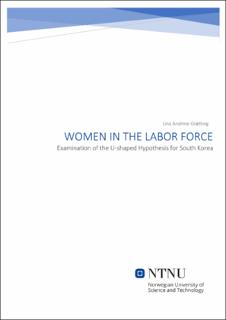| dc.contributor.advisor | Mignon, Doriane | |
| dc.contributor.author | Grøtting, Lina A. | |
| dc.date.accessioned | 2022-07-02T17:20:56Z | |
| dc.date.available | 2022-07-02T17:20:56Z | |
| dc.date.issued | 2022 | |
| dc.identifier | no.ntnu:inspera:112090681:112159232 | |
| dc.identifier.uri | https://hdl.handle.net/11250/3002399 | |
| dc.description.abstract | Denne oppgaven tar for seg forholdet mellom økonomisk utvikling, målt ved en økning i BNP per capita, og andelen kvinner i arbeidsstyrken i Sør-Korea de siste 40 årene. Analysens grunnlag er "den U-formede hypotesen"; en teoretisk og empirisk antydning til at kvinnelig yrkesdeltakelse først faller i det første fasene av økonomisk utvikling, før den øker i de senere fasene. En økonometrisk modell av forholdet, estimert ved vektoriell autoregresjon, bruker tidsseriedata på makronivå for Sør-Korea over årene fra 1980 til 2019 fra Verdensbanken og OECD. De empiriske resultatene finner ikke entydig og robust dokumentasjon av et U-formet forhold mellom andelen yrkesaktive kvinner og økonomisk vekst i Sør-Korea for den undersøkte tidsperioden. Resultatene antyder at motløs arbeider-effekten kan være gjeldende. Inkonsekvent med økonomisk teori og tidligere empirisk arbeid assosieres økt kvinnelig utdanning med redusert kvinnelig yrkesdeltakelse.
En analyse av tversnittdata på arbeidsmarkedsforholdene i landets provinser, kombinert for årene 2015, 2017 og 2019, er inkludert i et forsøk på nærmere å undersøke avgjørende faktorer i arbeidstilbudsavgjørelsen til Sør-Koreanske kvinner i dag. Funnene indikerer at sosialt stigma og tradisjonelle kjønnsroller har en negativ effekt. Videre antydes det at en økning i offentlige utgifter til familie- og arbeidsledighetsordninger kan øke kvinnelig deltakelse, hvilket kan bidra til å forebygge den forventede økonomiske stagnasjonen og nedgangen i arbeidsstyrken i landet på bakgrunn av lave fødselstall og en aldrende befolkning. | |
| dc.description.abstract | This thesis addresses the relationship between economic development, captured by an increase in GDP per capita, and the rate of female labor force participation in South Korea the last 40 years. The basis of the analysis is “the U-shaped hypothesis”; a theoretical and empirical suggestion that female participation initially decreases then increases over the stages of economic development. Using time series data on the macro level for South Korea over the years of 1980 to 2019 from the World Bank and the OECD, an econometric model was estimated by vector autoregression. The empirical results do not find unambiguous and robust evidence of a U-shaped relationship between female labor force participation and economic growth in South Korea for the examined time period. However, the results suggest the presence of the discouraged worker effect. Contradictory to economic theory and previous empirical work, boosts in female education is associated with a decrease in female labor force participation.
An analysis of cross-sectional data of labor market conditions in the individual provinces pooled for the years of 2015, 2017 and 2019 is included in an attempt to further explore determinants of the labor supply decision for South Korean women today. The findings imply a negative effect of social stigma and traditional gender roles, as well as a suggestion for policy interventions in order to boost female participation in prevention of economic stagnation due to a predicted contraction of the labor force in a country in the face of low fertility rates and an aging population. | |
| dc.language | eng | |
| dc.publisher | NTNU | |
| dc.title | Women in the Work Force: Examination of the U-shaped Hypothesis for South Korea | |
| dc.type | Bachelor thesis | |
